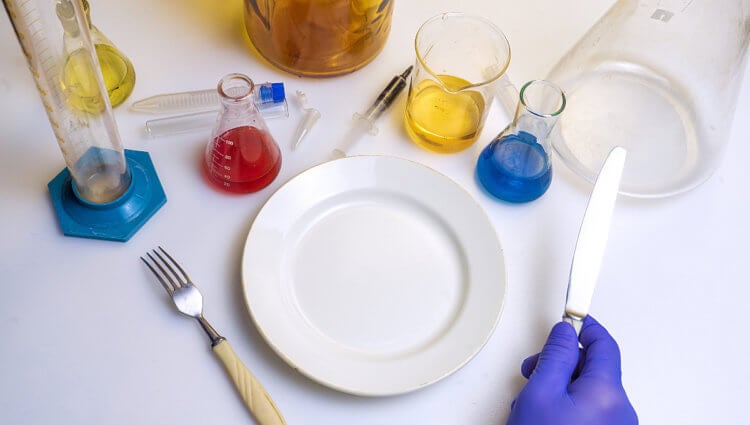It is believed that everything natural is beneficial, and products that contain chemicals are harmful to the body, be it hair shampoo or food. But is this really all there is to it and is it worth purchasing products exclusively labeled “GMO-free”? The truth is that absolutely everything around us, including food, is made up of chemicals. This does not mean, however, that we should treat all chemicals the same. At the same time, the media often worsens the image of chemistry – positive news usually concerns the invention of drugs for a particular disease, and negative news about everything else – from chemical spills resulting from a train crash to ammonia leaks and against toxic substances. Is it any wonder that the achievements of chemists, to whom we owe our current standard of living, are constantly forgotten?

Should we avoid everything unnatural? And are all chemicals really dangerous to health? Image: www.foodsafetynews.com
Contents
- 1 Atoms and molecules
- 2 Chemistry around us
- 3 Harmful and safe chemicals
- 4 What to do?
Atoms and molecules
Chemistry is the science that studies the composition, properties and structure of matter, and the ways in which they can change from one form to another. But this definition is too broad, because chemistry is not the only science that studies the composition and transformations of matter. Matter is also made up of complex materials, such as wood, which is used to make furniture, or cotton, which is used to make various fabrics.
Chemists are unique in that they understand or explain everything, even those subjects that are important to consumers in everyday life, in terms of the properties of just over 100 kinds of atoms present in all matter and the amazing variety of molecules that are formed by the formation and breaking of bonds between atoms.

In chemistry, any object is considered as atoms and molecules. Image: www.thoughtco.com
This means that chemistry is an approach, not a subject matter, and helps professionals create functional and interesting objects, and consumers help evaluate counterfeit or unsafe products.
More interesting articles about the latest discoveries in science and high technology read on our channel in Yandex.Zen – articles that are not on the site are regularly published there!
So, «natural products» no different from synthetic molecules produced in a laboratory; both are “chemicals” when understood in terms of molecular structure or properties. When people talk about products being «chemical-free», they usually mean that the material occurs in nature and therefore was not developed by chemists, even if the molecules created by the chemists are identical.
Chemistry around us
The materials that make it possible to make almost everything around us were developed by chemists. Isolation of metals from ore – chemistry. Synthesis of lightweight plastics, polymers and composites – chemistry. The purification of silicon, which led to the revolution in computers and the Internet, not to mention solar panels, is also a matter of chemistry. Energy-efficient lighting, thanks to the use of white LEDs, owes its appearance to even more specialists from this field of science.

Chemistry surrounds us every day. Image: www2.sci.hokudai.ac.jp
Note that chemistry itself emerged thanks to advances in other disciplines, in particular physics. The discovery of quantum mechanics in the early twentieth century expanded the theoretical understanding of chemistryso that many chemical reactions and behavior can now be predicted using sophisticated computer programs. At the same time, chemists' study of molecules and atoms has provided important data for physicists seeking a deeper understanding of the world around them.
Read also: What is the connection between lasers, space and molecular chemistry?
Let's take batteries for example. Lithium, which modern batteries operate on, is a scarce element. It is difficult to isolate, and extraction does not come without environmental consequences, which is why scientists are looking for an alternative. The same applies to the next generation of solar cells – new materials are required to create them. Currently, chemists are synthesizing them and quickly testing them in devices.

Everything in the world is interconnected. Image: static01.nyt.com
Researchers also continue to work with medical professionals to treat diseases ranging from rare to unfortunately common cancers, including developing new antibiotics and antimicrobials. Chemists also study the natural world and how we influence it. Climate change may have its roots in chemical reactions that release CO₂ into the atmosphere, but to stabilize the climate, scientists will also need to come up with new ways to capture and store CO₂ or convert it into something else.
This is interesting: Household chemicals can cause aggressive forms of cancer
Harmful and safe chemicals
But what about the chemicals contained in food and everyday items? Highly toxic substances such as lead, mercury and methylene chloride should not be contained in food products because they are toxic, have no nutritional value and are not equivalent to the chemicals that make up proteins, fats and carbohydrates.
Thus, the assumption is that toxic metals and synthetic chemicals such as PFAS (a group of synthetic organofluorine compounds containing many fluorine atoms) found in food are the same chemicals as essential elements such as potassium in bananas , misleading and harmful to health.

Carcinogens and compounds harmful to health are found in some foods. Image: static01.nyt.com
More on the topic: Shish kebab and barbecue emit deadly carcinogens when fried
That's because some chemicals (besides lead and mercury) are so toxic that almost any exposure to them is cause for concern: PFAS, for example, are known as «forever chemicals» and even in very small quantities can harm pregnant women, cause cancer and damage the immune system.
Treating all chemicals in food the same goes against science .
Chemicals like tricholorethylene (TCE) also cause many types of cancer, and bisphenol A (BPA), a chemical widely used in the production of clear, hard plastics, causes immune and reproductive harm. systems and negatively affects learning and memory.

Plastic pollutes not only the environment, but also the human body. Image: assets.newatlas.com
Well, substances such as phthalates (contained in packaging, toys, cosmetics, medical products, bank plastic cards, carpets and wall coverings, linoleum, hoses, pipes, upholstery inside cars, window frames, paints, lubricants and detergents) are extremely are toxic and disrupt the normal functioning of the hormonal system.
Don't miss: Every week we inhale microplastics the size of a credit card: how deep does it penetrate?
What to do?
Over the past few years, civil society organizations around the world have been demanding that government agencies review the safety of chemicals that are known to pose health risks. Many requests, however, have not yet been addressed.
The main requirement is that manufacturing companies, along with the Food and Drug Administration, provide accurate information about chemicals that can cause harm health and well-being, rather than hiding them and masking data.

Not all chemicals are dangerous, but many are. Image: i0.wp.com/bioplasticsnews.com
You may be interested: What types of microplastics exist and why are they found even in the clouds?
Unfortunately, the reality is that a considerable amount Harmful chemicals are found in both food and everyday items. This, however, does not mean that absolutely all consumer products with added chemicals are dangerous. The main thing is to be attentive to what surrounds us and avoid toxic materials and products.